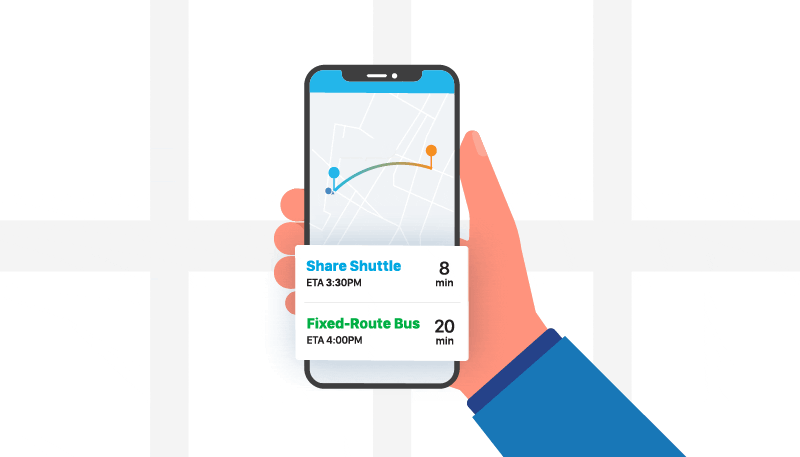The immense promise of on-demand public transportation is enough to make any city leader or public transit operator ask, “Where do I sign?” Microtransit has the opportunity to fill the first- and last-mile gap, serve longstanding transit deserts, and reduce things like traffic and emissions by bringing the bus network into the 21st century. And let’s be real: the idea is especially alluring for city planners who constantly receive flak about the quality of public transportation in their communities.
Investing in on-demand transit technology can often be positioned as a silver bullet, so decision makers tend to find a partner who promises the sun and the moon, all under budget. This is usually where the problems creep in.
While plenty of providers claim to pool passengers heading in the same direction, there are clearly a number of other intricacies involved with operating a public transit network. Beyond the major complexities like integrating microtransit with your fixed route network, decision makers are all too often left with partners who aren’t as responsive as they’d like, technology that isn't as good as they thought, and a service that just isn't delivering as promised.
That silver bullet you were promised? It’s looking more like a squirt gun. If that sounds familiar, you might be feeling a little bit of buyer’s remorse and working your way through a few stages of regret:
- Confusion – This is new to me, and I have a lot of questions. Where did the team go who made all these promises? I need help, and I don’t know where to turn.
- Panic – We just promised our residents a groundbreaking new public transportation system, but it’s not working nearly as well as advertised. How are we going to fix this?
- Anger – How could our partner not realize this is an enormous problem? We’re missing blatantly obvious features, and functionality they promised would work. Clearly this is something we’d need to operate a successful service.
- (Reluctant) acceptance – If our vendor can’t help us fix this, let’s get scrappy and figure out a workaround by ourselves.
- Dissatisfaction, defeat, do-over – It’s not working, but we see the potential. Let’s take what we’ve learned and do this the right way, with the right partner.

So, what really went wrong?
First, anyone experiencing these phases of panic and dissatisfaction deserves a break. While on-demand transportation is nothing new, the way today’s cities and transit agencies are employing it is new. Knowing the right questions to ask before taking the leap can be tricky. Sometimes, it’s hard to know whether the new service will catch on with riders in only a couple of months. There’s a slight learning curve, basic kinks to work out, and passenger education and adoption.
But after a few months, it usually becomes clear if the microtransit network is going to meet your goals. The turning point often comes down to key capabilities, and whether you chose a true partner, or a basic vendor. At the end of the day, microtransit needs to support and complement your transit network, and the team you choose has a lot to do with whether that actually happens. But launching a service with missing parts — and with a vendor who seems more interested in their next sale than helping you succeed — is a tried and tested recipe for disaster. These are the main elements of every thriving microtransit network:
- A partnership built on success – After the service launches, understand exactly how you and the partner will work together. When you have questions, urgent issues, or feature requests, what does that communication look like? No city can do this alone, so find a partner, not a vendor. One that is actively involved with your success.
- Teams that remain flexible – Unlike nailing down a bus route and settling on a time table, on-demand transportation requires a level of flexibility, especially during the first few months of service. Partners should be able to identify issues quickly and resolve them proactively.
- A service that complements mass transit – On-demand networks should work hand-in-hand with bus and train lines, not compete with them. Choosing the right service zones, hours, and other parameters can have a lot to do with whether your microtransit network is attracting new riders, or just shuffling them between existing transit options. The partner needs to help create a service that complements existing fixed routes, which might include building an app that shows both in one place.
- Tech that works, and is improving – Two important aspects of any service include a commitment to technology that delivers, and a partner who is investing in its success. That means consistent software improvements and new feature rollouts, making the overall experience better for both riders and operators.
Missing any of these components is like going for a road trip and running out of gas. Thankfully, a course correction late in the game is easier than you’d think.

Making it right.
Just because you’re experiencing buyer’s remorse doesn’t mean you should let your microtransit dreams fall by the wayside. On-demand transit is still proven to solve a huge variety of transportation woes, but the implementation has to be thoughtful and specific. The partner you choose next has to have the tools and capabilities to actually make it work.
Interested in knowing what features you might really need? Use our checklist to pick the type of problems you’re aiming to solve using microtransit, and let us tell you the various service elements you should consider before choosing your next technology provider.




%206.png?width=71&height=47&name=The%20Buzz%20Blog%20Hero%20(1750%20x%201200%20px)%206.png)